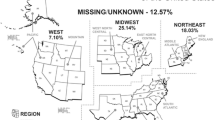Abstract
Purposes
Concerns have been raised regarding an apparent shortage of general surgeons in Japan, but the actual situation is actually not altogether clear. To clarify the trends in the number of general surgeons in Japan, we studied the number of doctors by specialty over time.
Methods
This study investigated the covered trends in the number of doctors over time, a comparison of work formats (employment in hospitals versus clinics), and the trends in the ratio of female doctors. We used data from the Survey of Doctors, Dentists and Pharmacists from 1996, 1998, 2000, 2002, 2004, and 2006.
Results
Between 1994 and 2006, the number of general surgeons fell by 12.7 %, from 24,718 to 21,574. More than 20 % of the general surgeons, aged 25 to 54 years old, either changed jobs or changed specialties between 1996 and 2006. Among the general surgeons, aged 25 to 54 years old, the number of those working in hospitals fell by 2,567 (16.2 %) between 2000 and 2006, while the number working in health clinics rose by 348 (19.8 %). The ratio of female general surgeons rose from 2.4 % in 1996 to 4.5 % in 2006.
Conclusions
The decrease in general surgeons in Japan is largely often due to mid-career job separation.




Similar content being viewed by others
References
Doctor shortage takes a toll in Japan (AFP web site). 2008. http://afp.google.com/article/ALeqM5i5XP-O252HC9opxHZ6aKgsXRKjqw. Accessed 5 Mar 2010.
Kmietowicz Z. Shortage of surgeons might threaten NHS targets. BMJ. 2005;330:379.
Sanchez M, Sariego J. The general surgeon shortage: causes, consequences, and solutions. South Med J. 2009;102:291–4.
Lynge DC, Larson EH, Thompson MJ, et al. A longitudinal analysis of the general surgery workforce in the United States, 1981–2005. Arch Surg. 2008;143:345–350 (discussion 351).
Williams TE Jr., Ellison EC. Population analysis predicts a future critical shortage of general surgeons. Surgery. 2008;144:548–554 (discussion 554–556).
Ehara A. Asu no geka syujyutu ha dare ga surunoka. Nichii zasshi. 2008;136:2247–8.
The study of doctor, dentist and pharmacist (in Japanese) (Ministry of Health, Labour and Welfare of Japan web site). 2006. http://www.mhlw.go.jp/toukei/list/33-18.html. Accessed 5 Mar 2010.
Ide H, Yasunaga H, Kodama T, et al. The dynamics of obstetricians and gynecologists in Japan: a retrospective cohort model using the nationwide survey of doctors data. J Obstet Gynaecol Res. 2009;35:761–6.
Nomura K, Inoue S, Yano E. The shortage of pediatrician workforce in rural areas of Japan. Tohoku J Exp Med. 2009;217:299–305.
Doctor acquitted of C-section death case believed led hospitals to rethink, curtail obstetrics care (The Japan Times web site). 2008. http://search.japantimes.co.jp/cgi-bin/nn20080821a1.html. Accessed 5 Mar 2010.
Tokuda Y, Hayano K, Ozaki M, et al. The interrelationships between working conditions, job satisfaction, burnout and mental health among hospital doctors in Japan: a path analysis. Ind Health. 2009;47:166–72.
Wada K, Arimatsu M, Higashi T, et al. Doctor job satisfaction and working conditions in Japan. J Occup Health. 2009;51:261–6.
Report on the hospital (in Japanese) (Ministry of Health, Labour and Welfare of Japan web site). 2009. http://www.mhlw.go.jp/toukei/list/80-1.html. Accessed 5 Mar 2010.
Kaneto C, Toyokawa S, Inoue K, Kobayashi Y. Gender difference in doctor workforce participation in Japan. Health Policy. 2009;89:115–23.
Toyabe S. Trend in geographic distribution of doctors in Japan. Int J Equity Health. 2009;8:5.
Conflict of interest
The authors declare no conflict of interest.
Author information
Authors and Affiliations
Corresponding author
Rights and permissions
About this article
Cite this article
Mizuno, Y., Narimatsu, H., Kodama, Y. et al. Mid-career changes in the occupation or specialty among general surgeons, from youth to middle age, have accelerated the shortage of general surgeons in Japan. Surg Today 44, 601–606 (2014). https://doi.org/10.1007/s00595-013-0613-6
Received:
Accepted:
Published:
Issue Date:
DOI: https://doi.org/10.1007/s00595-013-0613-6




